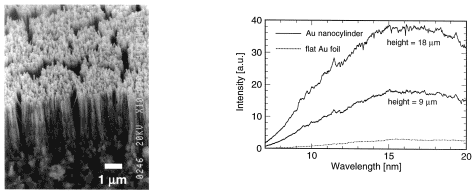Plasma on Nanostructure-Array Targets
Physical Science Laboratory
X-ray generation from femtosecond-laser-produced plasma is an attractive way to obtain short pulse x-rays. However, due to the formation of solid density plasma at a target surface, the interaction depth of the femtosecond laser pulses is restricted to skin depth, i.e., around 50 nm, and thus the conversion efficiency is limited. In order to improve the conversion efficiency, a double-laser-pulse excitation technique is commonly used. After the expansion of the preformed plasma created by the first laser pulse, the expanded low-density plasma is heated effectively by the intense second laser pulse, and large x-ray conversion efficiency is obtained. But with this technique, the generated x-ray pulse duration is broadened from 5 ps (single pulse excitation) to around 100 ps due to the slow cooling rate of low-density plasma. To overcome these problems, we utilized nanostructure-array targets to extend the interaction depth of the laser pulse to around 20 μm. Large-volume plasma with high-local-density is created on these targets by a single laser pulse excitation, and large soft x-ray conversion efficiency enhancement can be achieved while keeping the short x-ray pulse duration.
Two types of nanostructure-arry targets were used in our experiment. One is a nanohole-array structure [1]. This structure was made by utilizing the anodic oxidation of an aluminum plate. By a self-ordering process, an anodic-alumina layer that has central, cylindrical, and uniformly sized pores that run perpendicular to the surface is formed on the aluminum plate. The pore diameter is around 90 nm and the distance between the adjacent pores is 100 nm. The other structure is a nanocylinder-array structure [2]. After filling up the alumina nanoholes with Au by electrodeposition, the alumina part was removed (Fig. 1). The cylinder diameter is 80 nm and the cylinder heights are 9 and 18 μm.
These targets were irradiated with 100 fs laser pulses at the peak intensity of 1.5X1016 W/cm2, and generated soft x-ray fluence spectrum was measured (Fig. 2). Around a 50-10 fold soft x-ray fluence enhancement compared with a conventional plane surface target was achieved at 5-25 nm wavelengths. X-ray pulse duration on both nanostructure-array targets was 17 ps, which is shorter than that obtained by the double-laser-pulse excitation technique on a plane surface target or by synchrotron radiation. The x-ray pulse peak intensity on the nanostructure-array targets was 5-7 times higher than that on a plane surface target.
[1] T. Nishikawa et al., Appl. Phys. Lett. 75 (1999) 4079.
[2] T. Nishikawa et al., International Conference on X-ray Lasers 2000.

|
|